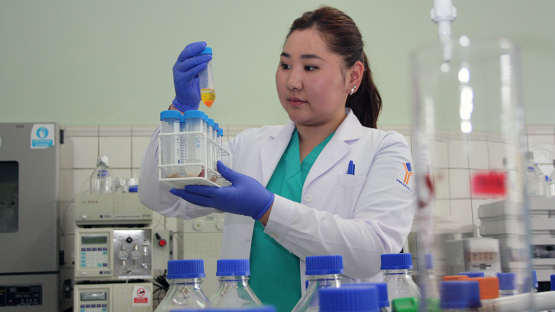Laboratories undergo external independent evaluation to assess, for instance, how equipment performs, the level of training and competence of staff, quality control and assurance systems, and participation in interlaboratory and proficiency testing schemes. Accreditation is granted for a limited period, followed by reassessment to determine if the accredited status should be extended. This ensures that laboratories continue to meet and maintain standards.
“It is not unusual for an accredited [laboratory] to be denied re-accreditation. To keep these standards, we need to improve, have relevant laboratory inputs and participate in training and in proficiency tests. The IAEA and FAO have continued to support us in all these, without which accreditation would be impossible,” said Uzma Maqbool, Deputy Chief Scientist at Pakistan’s Nuclear Institute for Agriculture and Biology (NIAB). The Joint FAO/IAEA Centre supports the safe and appropriate use of nuclear and related technologies in food and agriculture through adaptive research and development at its own laboratories in Seibersdorf, Austria, and through the coordination of more than 25 research projects involving about 400 research institutions. The Centre also facilitates capacity-building and technology transfer to over 200 national and regional technical cooperation projects and provides technical and policy advice to decision makers.
NIAB, which was first accredited in 2017 following support from the Joint FAO/IAEA Centre, has been re-accredited through 2023 to test drug and chemical residues in animal production. “This achievement continues to ensure confidence among the users of the laboratories’ services, including EU-registered exporters of sheep casings from Pakistan, enhancing international trade,” Maqbool said.
In Mongolia, with IAEA and FAO support, the State Central Veterinary Laboratory (SCVL) had its accreditation extended through 2023. SCVL received assistance in staff training on analytical methods and protocols. It also received purchased analytical equipment and assistance to participate in proficiency testing. “Food analysis is a very complex task because there are a large number of drugs used for therapeutic and prophylactic purposes in animals bred for food,” said Ts Enkhtuya, Head of the Service for Diagnosis and Surveillance of Environment Induced Disease and Food Safety at SCVL. “High-precision technologies and methods are required to detect their decomposition products in matrix with different biological structures and fine-grained chemicals in very small quantities.”
Despite interruptions related to the COVID-19 pandemic, SCVL continued to operate, analysing more than 28 000 food samples for pathogens, veterinary drug residues, toxic metals, radionuclides and mycotoxins, which could create serious health risks in human and animal species.
Other countries have benefited from IAEA and FAO support to gain accreditation or re-accreditation:
- The Botswana National Veterinary Laboratory, a key player in promoting the country’s lucrative beef export market, expanded its scope of ISO accreditation, which has been approved for extension up to 2023.
- In Namibia, the National Standards Institution received accreditation through 2023 for an expanded scope, with the addition of two analytical methods.
- The Onderstepoort Veterinary Research Campus in South Africa was re-accredited until November 2022 for two techniques to test veterinary drugs in animal tissue, fluids, products and feed, as well as fish and honey.
- The Uganda National Bureau of Standards, which is responsible for testing microbial and chemical hazards in food for local and international consumption, attained an accreditation extension to 2026.
Read more about the IAEA and FAO’s work to ensure food safety and quality.







